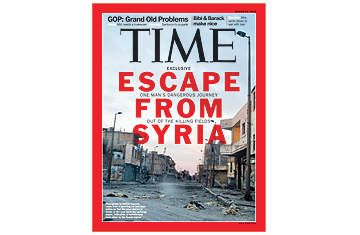
(5 of 6)
Fighting to remain calm, Daniels began trying to drag the stretcher, but he couldn't move it. He weighed the option of carrying Bouvier over his shoulder but quickly realized it would be impossible. "It was a nightmare," he says. "We were alone. I didn't know what to do. She was saying, 'We have to move. We have to move.' And I was saying, 'Wait, let me think.' I thought, O.K., if this is the time for us to die, it's O.K. But I did not want us to suffer--getting shot and bleeding to death for hours."
Then Daniels heard a buzzing noise. It was a far-off motorbike and it was headed their way, its headlight dim but welcome. Daniels ran toward it, shouting for help, and the driver stopped. They sat Bouvier on the bike, jamming the rifle between her and the driver, with Daniels perched behind. Bumping through the darkness, toppling over a number of times, they headed not away from Bab Amr but back to what little shelter it offered.
Conroy managed to make it to the Lebanese border. A couple of days later, Espinosa too got across. But perhaps 13 Syrian activists died in the attack on the tunnel. The hopes of Bouvier's and Daniels' friends and relatives in France were crushed when French President Nicolas Sarkozy retracted a statement that the two French journalists had also made their way to safety.
Back in the hideout, a Syrian activist laid out a last-ditch escape plan for the next day, Feb. 27. They would disguise Bouvier in Islamic dress and try another route, which the activist admitted was even more dangerous. "Yesterday," he said, "my friend was killed on that road." The French journalists had no choice. Bouvier's leg was deteriorating, and everyone expected the Syrian army to launch an attack at dawn.
"We'll try it," they said. They were bundled into a car with fighters from the Free Syrian Army (FSA), a group of army defectors battling Assad's forces. In a series of vehicles, they drove through terrain held by government forces. "I cannot give details because the route was absolutely secret," Daniels says. "But it was very, very dangerous. We were very, very scared."
When they finally stopped at a safe house, they were overwhelmed by food and warmth. Everyone wanted to have a photo taken with Bouvier, who had become famous since the YouTube video. "She was like an icon of the revolution," Daniels says, laughing. After two nights, the FSA escorts took them to a second safe house before smuggling them across into Lebanon on March 1. In all, the escape route was 25 miles (40 km) long but had taken almost four days to travel. Bouvier and Daniels turned on their mobile phones and sent ecstatic messages to friends. "We are out," Daniels texted photo editor Patrick Witty at TIME. "And Edith is safe!"
Flown back to France, the two were greeted at the airport by Sarkozy, who praised "the knightly spirit of ... William Daniels, who at no point abandoned his colleague, even though he was not injured and could have escaped." The tribute left Daniels uneasy. He did not want to be portrayed as a hero.
